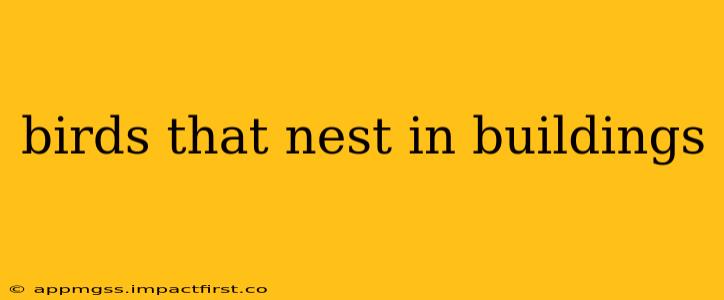Many bird species have adapted to human environments, finding shelter and nesting sites in and around buildings. This adaptation, while sometimes inconvenient for humans, offers a fascinating glimpse into the resilience and adaptability of avian life. This guide explores common birds that nest in buildings, their nesting habits, and how to coexist peacefully.
What Attracts Birds to Nest in Buildings?
Several factors entice birds to build nests in or on buildings. Firstly, buildings offer protection from predators, providing a safe haven for vulnerable chicks. Secondly, the structural features of buildings, such as ledges, crevices, and eaves, mimic natural nesting sites. Finally, the availability of nesting materials nearby, like loose fibers and twigs, makes building construction easier.
Common Birds That Nest in Buildings:
Here's a closer look at some species frequently found nesting in buildings:
House Sparrows:
These ubiquitous birds are arguably the most common building nesters. They readily adapt to human environments, building nests in cavities, under eaves, and even within building walls. Their nests are often bulky, untidy affairs made of straw, twigs, and other readily available materials.
European Starlings:
Similar to house sparrows, European starlings are highly adaptable and often nest in large numbers in buildings. They prefer cavities and crevices, often exploiting existing holes or creating their own. Their nests are generally less bulky than those of house sparrows.
Rock Pigeons:
These city dwellers are masters of urban adaptation, nesting on ledges, windowsills, and rooftops. Their nests are simple structures of twigs and other debris, often located in exposed areas.
Barn Swallows:
While they prefer open barns, barn swallows will occasionally nest under the eaves of houses. Their nests are distinctive mud cups, often built in sheltered spots.
House Martins:
Close relatives of barn swallows, house martins frequently nest under the eaves of houses, constructing their characteristic mud nests. Their nests are usually attached to the underside of eaves, offering protection from rain and predators.
What are the potential problems with birds nesting in buildings?
Mess: Bird droppings can be unsightly and can damage property over time, particularly if they accumulate in large quantities.
Noise: Some birds are quite vocal, especially during breeding season, which can be disruptive for building occupants.
Damage to Buildings: Nesting activities may, in some instances, lead to damage of building materials through the creation of nesting sites or accumulation of nests and droppings.
How to discourage birds from nesting in unwanted areas?
While promoting biodiversity is important, there are methods to deter birds from nesting in areas where their presence poses problems. Modifying building features such as sealing holes and crevices or installing bird spikes can be effective. However, always consider the welfare of the birds and avoid methods that might harm or trap them. Using natural deterrents like predator decoys or reflective materials can also be explored. It’s important to remember to implement deterrents before birds begin nesting, as this is less stressful for them.
How can I tell if a bird’s nest is active?
Look for signs of recent activity. This includes the presence of adult birds feeding young, fecal sacs near the nest, or visible movement within the nest itself. If you see these signs, it is crucial to avoid disturbing the nest.
Are there legal restrictions on removing bird nests?
In many regions, it's illegal to disturb or remove active bird nests, especially during the breeding season. Always check with local authorities and wildlife agencies before taking any action concerning a bird's nest.
What should I do if I find an injured bird?
Contact your local wildlife rehabilitation center or animal control. They are equipped to provide the necessary care for injured birds. Never attempt to handle an injured bird yourself, as you could cause further harm.
By understanding the behavior of birds that nest in buildings, we can find ways to coexist peacefully, appreciating their presence while protecting our property. Remember, responsible coexistence is key to ensuring the well-being of both humans and wildlife.
